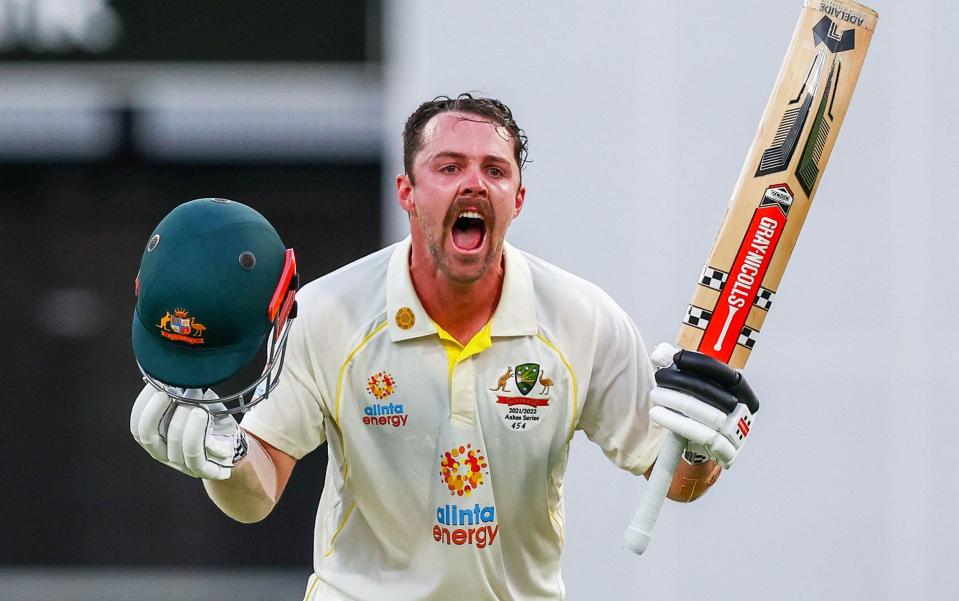In one brutal session, Travis Head may have hit Jack Leach out of the Ashes

Before the first Test in Brisbane, Adam Gilchrist presented a new baggy green cap to debutant Alex Carey. The hope, perhaps, was that Carey would assume the Gilchristian role as a left-handed swashbuckler reordering the feel of Test matches from the middle order.
Instead, Gilchrist had an unlikely impersonator at the Gabba. Over his 19 previous Tests, Travis Head has been a cricketer whose place is seldom far from scrutiny. His response has generally been to accumulate rather than dash, scoring at under one run every two balls and almost invariably earning the description ‘nuggety’.
In his last Test series, against India a year ago, Head eked out 62 runs in 158 balls in three innings and was then dropped. His recall for this series was contentious. Head floundered for Sussex last summer, and perhaps only won out over Usman Khawaja because of his relative youth: at 27, he is seven years Khawaja’s junior.
When Head arrived at the crease on the second day, he came spotting a new moustache. He also brought the promise of a new more adventurous approach: in Australian domestic cricket this summer he scored 230 off 127 balls in a 50-over game against Queensland and has scored at a strike rate of 72 in the Sheffield Shield.
There were few indications of this new style as Head scrapped to six runs off 18 balls; four of these came with a thick edge past gully off Ollie Robinson. But while Robinson would not have been too alarmed even when he strayed onto Head’s pads and was flicked for an all-run four, Head was putting in place the groundwork to launch his all-action attack on England's two spin options: Joe Root and Jack Leach.
Head was next on strike to Ben Stokes, who was being reintroduced for his second spell while nursing a knee injury and playing after five months without a first-class appearance. With Australia 65 runs ahead and the second new ball still 19 overs away, Head could have settled into low-risk accumulation on his return to Test cricket.
Instead, Head recognised a fundamental truth. Unlike in England, where the pitches and the Dukes ball often offers prodigious movement throughout the day, in Australia batting becomes notably easier as the innings progresses. The period before the second new ball, in the evening session, is a perfect cocktail for batting. The ball has stopped offering any assistance but the sun is still blazing, the pitch is true and the bowlers - especially when as deprived of match practice as England's - are fatigued.
Stokes’ second delivery to Head was too straight and too short and pulled disdainfully for four. Next ball, Stokes erred too short and too wide; Head lashed him for another boundary. Stokes ended the over straying onto the pads; Head flicked him for his third four in the over.
The tempo for Head’s innings was set. In lieu of the approach he had used in the 2019 Ashes, he would embrace an altogether more daring spirit.
With Robinson and Stokes both flagging and Leach struggling for control, Root turned to himself, reasoning that his off-spin should prove effective against the left-handed pair and could, at the very least, contain. Head did not agree. After driving his first ball from Root to extra cover, he promptly skipped down the pitch to his next ball and cleared long-on.
Disdain for finger spin is deeply ingrained in Australian cricket and so when Leach returned to the attack, Head brought the same chutzpah he had shown against Root. Just like against Root, Head went down the wicket to his second ball from the bowler; Leach saw him coming and brought back his length, but Head quelled his advance and got a thick edge for four.
If there was risk in such a buccaneering approach, this was mitigated by the dearth of spin the Gabba offered. Head’s gallivanting also led the spinners to err in their line and length. In his second over to Head, Leach twice sprayed the ball down the leg side to concede boundaries. Head’s footwork was so decisive, and his confidence so great, that he even cleared the man at long-on to launch a six off Leach.
Leach might have expected that the evening spell would provide a reprieve after his first eight overs had yielded 62 runs. Instead, Head doubled down on Australia’s targeting of the under-siege spin bowler: his last three overs leaked 33 runs. Following David Warner earlier in the day, and Rishabh Pant earlier this year, Head again exposed Leach’s struggles against left-handers. His fine average of 24.7 to right-handers in Tests soars to 60.9 against lefties - a major concern for Root and head coach Chris Silverwood given that Australia have four left-handers in their top seven.
Rather than see out the period until the second new ball, Head spied the chance to plunder, scoring 50 from 29 balls against England's two spinners. With Stokes exhausted and Robinson off the field, Australia added 108 in the last 19 overs before the second new ball. In a little over an hour, Australia converted a total of 212-5 - a significant, but far from decisive, advantage - into what now appears an insurmountable one. It was a lesson in how Test cricket, for all the discipline it requires, also rewards those who recognise when the odds favour showing more adventure.
When the second new ball finally came, all that remained for Head was to drive the second ball, from Chris Woakes, through mid-on for four. As Head let out a guttural roar, he could revel in how his audacity had brought a moment of cricketing nirvana: a century off 85 balls, the third fastest in the history of the urn.

 Yahoo Sport
Yahoo Sport 





































